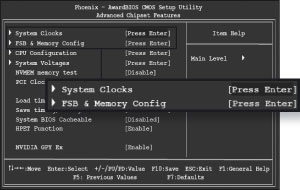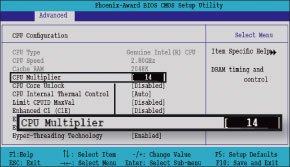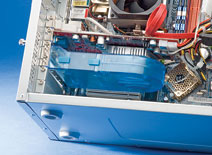'Power boost' for computers
In fact, you do not necessarily have to spend a lot of money to equip your desktop computer with advanced features that are only available for computers dedicated to gaming and graphics processing needs. Some simple and economical upgrades can still help to boost your system's performance to new heights.
With elementary level, you can apply overclocking method directly on the motherboard of the computer. Overclocking can improve system performance by requiring the processor (CPU) and graphics chip to run faster than the default setting. Most CPUs can operate comfortably at frequencies higher than those used by computer manufacturers.
If you're a careful person, you can overclock your computer without any risk. Once overclocked, the CPU will run faster and of course hotter, but the system temperature monitoring and control can be done quite easily. Please note, overclocking will damage warranty regulations. In some cases, you may not notice any significant performance improvements and it's best to bring the system back to its original state.
If you buy a motherboard or buy an 'outdated motherboard' computer, you need to use a 3rd-party Windows utility to perform overclocking instead of searching, Tweak the parameters in the PC Setup program of the computer. Most newer motherboards offer overclocking tools in the included CD. If there is no other way, you must open the PC Setup utility by pressing a notified key just before Windows is started (usually DEL or F2 keys). In the BIOS settings, you find the parameter setting for system clock and FSB - usually they are in Advanced Chipset Features (Figure 1). Note, the name and how to set these values may vary depending on the type of BIOS or computer.
The only way to find out the maximum speed of the CPU is to risk the test setup. Also, check out other users' experiences from overclocking forums like Extreme Overclocking, EarthWeb Hardware or Xtremevn.com.
Essential work
You have 2 ways to overclock the CPU, one is to increase the CPU multiplier, the other is the system bus (FSB) impulse - FSB has the function of controlling RAM and motherboard. In particular, changing the CPU multiplier is easier to implement. For example, if the computer's FSB is set at 200MHz and the multiplier is 14, the CPU will run at 2.8GHz (figure 2), when the multiplier is increased to 16, the CPU speed will reached 3.2GHz. However, with the exception of high-end CPUs such as AMD's Athlon FX series or Intel's Extreme Edition series, all new CPUs are 'locked up' and that's why most lovers overclock Currently, it has to switch to the form of increasing FSB clock value - a much more complicated procedure than increasing the CPU multiplier.
 'Power boost' for computers Picture 1
'Power boost' for computers Picture 1
Figure 1: Searching and setting up the system overclocking parameter in the PC Setup utility
Increasing the FSB clock value not only improves CPU performance but also speeds up data transfer between memory and CPU. However, this tweak may lead to a 'hang' of the device, so you must adjust the parameters related to RAM and the voltage level in the BIOS. You need to be very careful with these parameters because a small mistake can also cause catastrophe, so it is better to consult the experience from the forum or someone with experience. .
To know how fast your system can run, you increase the value of the BIOS in each step, then let the computer test for a while and check if there are any problems. If it is safe, continue to increase this value until the system occurs abnormally. From this 'dead' value, you reduce the clock rate by one step or even to a safer low level from your own point of view.
Cooling system
 'Power boost' for computers Picture 2
'Power boost' for computers Picture 2
Figure 2: Overclocking simply changes the CPU multiplier value in the BIOS
High-performance computers often require a good cooling system. CPU cooling fans available in the computer are often not enough 'power' to meet overclocking needs. The fan cooling CPU system costs less than 30USD, but you should buy products from big names like Thermaltake or Zalman - although expensive but they are stable and most importantly make less noise.
Meanwhile, gamers and computer users often prefer to equip liquid cooling systems because they are more efficient. This type of device includes a simple pump, pipes, radiators and a 'hot block' used to draw heat from the CPU.
If you're concerned about the liquid just a few millimeters away from the computer circuits, you can use the Monsoon II Like cooling fan from Vigor Gaming (130USD). Although not a liquid-type heat sink, Monsoon II is very efficient by combining a conventional fan with a powerful Peltiler cooler. This device is easier to assemble and takes up less space inside the chassis than many other large capacity CPU cooling fans.
Overclocking graphics card
Each graphics card has its own processor and RAM, so you can speed up each part using software. 3Dguru's RivaTuner 2 utility has long been used by overclocking users to refine graphics performance. However, overclocking is too common for leading graphics card manufacturers such as ATI and nVidia to provide overclocking tools on many graphics cards. In fact, in some cases, using ATI's Overdrive utility to overclock does not invalidate the warranty of the graphics card. In addition, you can use the Coolbits utility of nVidia or consult other solutions.
Tips for overclocking the system can also be applied to graphics cards: consult carefully on websites and forums specializing in overclocking to understand the process applied to your graphics card; Always remember to increase the clock to a small level, check to see if the device is running smoothly before continuing to increase the clock value, while carefully monitoring the time when the device falls into overheat. .
 'Power boost' for computers Picture 3 Figure 3: Keep the graphics card cool thanks to a specially designed fan, for example Antec VCool ($ 20) You can monitor the temperature of the graphics card with a Digital Thermal Probe device from HighSpeed PC ($ 15). If the temperature is too high, you should have a graphics card cooler like Antec's VCool ($ 20, figure 3).
'Power boost' for computers Picture 3 Figure 3: Keep the graphics card cool thanks to a specially designed fan, for example Antec VCool ($ 20) You can monitor the temperature of the graphics card with a Digital Thermal Probe device from HighSpeed PC ($ 15). If the temperature is too high, you should have a graphics card cooler like Antec's VCool ($ 20, figure 3).
However, the most effective method to improve the graphics processing performance for computers is still equipped with a high-end graphics card. Cheap computers with onboard graphics processors often run 'slow as turtles' when playing action games, video editing or handling large graphic files. Because these computers use system RAM at the same time for graphics processing tasks and system common tasks, the installation of an AGP or PCI Exoress standard graphics card - if the computer has a slot Blank - will greatly improve the graphics processing capability. To know what kind of graphics card your computer is using, you can look at the back of the computer: if the VGA or DVI signal port is not on the expansion card slot, then surely your computer uses it. Use integrated graphics card.
Before purchasing a new graphics card, you must ensure that you can disable the graphics system on the motherboard. On some computers, this will automatically be done when you insert a discrete graphics card into the slot, but on other computers you need to change some parameters in the PC Setup program. If you can't disable the graphics feature on the motherboard, you should consider buying a new computer or at least a new motherboard.
The generation of graphics cards that appeared two years ago may be difficult for some of the latest titles, especially those that require high screen resolutions or even moderately. You don't need to have a high-end card like the nVidia GeForce 8800 GTX ($ 600), but only one graphics card that is affordable for your budget.
Some notes: Some AGP-standard graphics cards are still available for sale and use, but this technology is going into a "regression" phase. Even if you find an AGP graphics card like that, you probably won't be able to use it for your future computer (often missing an AGP slot), so consider buying a new motherboard. Support PCI Express slot. If you intend to use Windows Vista, make sure that the graphics card comes with a Vista device driver and DirectX 10 support.
Many gaming computers cost about $ 5,000, equipped with two SLI or CrossFire graphics cards - usually a double card ($ 600) - operating on the 'rickshaw' principle to improve graphics processing. However, you can absolutely apply this solution to your computer if the motherboard is using SLI or CrossFire support. If the budget is tight, you can buy a card first, then buy it again when possible.
New motherboard equipped
If the motherboard you are using does not support modern technologies such as PCI Express (graphics card), SATA and RAID (hard disk) and dual-core processor, this is the chance for you to buy a new computer. If you are not ready for this, you might consider changing only the motherboard, CPU and RAM. NVidia's 650i motherboard supports the latest graphics cards, hard disks and other components. For example, the Asus P5N-E SLI (under $ 150) motherboard supports PCI Express, offers 2 SLI graphics card slots, SATA hard disk connectors and RAID connection support on the motherboard. If you don't need to use SLI, you can choose a motherboard like EVGA nForce 650i Ultra at a price of $ 120. Both motherboards support Intel's 2-core and 4-core processors, as well as Pentium 4 and Celeron (socket 775).
Indispensable utility
You can closely monitor the overclocking process with the following free utilities.
CPU-Z helps you check CPU clock speed, provides all the important settings and parameters for the CPU, motherboard and RAM of the system.
Alfredo Milani Comparetti's SpeedFan is a popular program, used to monitor the temperature of the CPU and the temperature inside the chassis, and you can set the fan speed so that it is best cooled. Meanwhile, the Desktop Utilities utility for Intel desktops will simultaneously display the temperature inside the chassis and the voltage level on a very user-friendly interface.
You hesitate because you don't know how you can affect your processor? Use the stability feature of your PC at every clock with Jouni Vuorio's CPU Stability Test tool. Alternatively, you can use the GIMPS Projec Prime 95 utility (Great Internet Mersenne Primes Search) to check your computer.
Not only that, but you can also refer to the motherboard manufacturer's website that you are using for proper tweaking utilities. Tech Power Up's SysTool will provide tools to overclock both CPU and graphics card.
Bui Xuan Toai
You should read it
- List of the best graphics cards according to the price segment
- How to fix the NVIDIA graphics card error is not displayed in Device Manager
- Top 7 best AMD graphics cards (GPUs) 2020
- 7 things you need to know about integrated and dedicated graphics cards
- Use GPU-Z to analyze graphics card parameters
- How to speed up onboard graphics card on window
- How to check the type of graphics card (GPU) on the computer
- 7 things you need to know about discrete GPUs
- Summary of compelling PC games without a separate video card
- Is the Intel HD Graphics 620 graphics card strong? What games can you play?
- How does the Intel HD Graphics 520 graphics card perform?
- Disable the NVIDIA component to speed up the computer






 What is Intel Turbo Boost? How does Intel Turbo Boost work?
What is Intel Turbo Boost? How does Intel Turbo Boost work? How to enable/disable Turbo Boost on Mac
How to enable/disable Turbo Boost on Mac What is Turbo Boost technology? Which machine is equipped with Turbo Boost?
What is Turbo Boost technology? Which machine is equipped with Turbo Boost? Boost Mobile Prepaid SIM Plans
Boost Mobile Prepaid SIM Plans Tips to help your computer use electricity more efficiently
Tips to help your computer use electricity more efficiently How To Boost Wi-Fi Signal on Laptop?
How To Boost Wi-Fi Signal on Laptop?